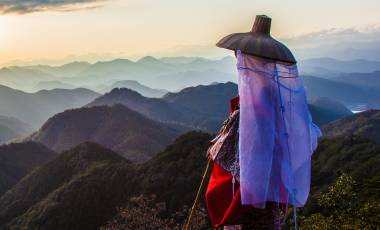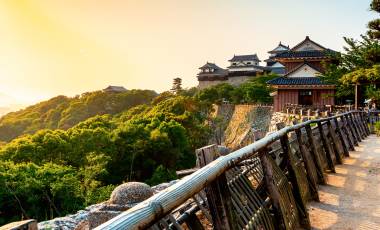Although I travelled from quite far away, (Vancouver Island, Canada), I was so very pleased at the kindness and friendly attitude of everyone in the group. I was the eldest in the group (73 years young), but had absolutely no trouble keeping up. I would say this trip is not for the feint of heart; even at the end of October/early November the days were quite hot (although the evening temps were perfect). We experienced no bugs and no rain throughout the week. Definitely expect long days and some arduous climbs as well as steep descents. Hiking poles were essential. It was occasionally windy and cool at each summit but I was able to hike in shorts all week. I’m quite used to climbing mountains and found this itinerary to be just perfect. The accommodation was basic but comfortable; the food was good but at times limited for me as a vegetarian. Breakfasts outside were fantastic and the triple-decker sandwiches that José made for us were to die for. You definitely won’t be disappointed.

Japan Walking Tours
Our Best Hiking Tours in Japan
Top 5 Places to Explore on Hiking Tours in Japan
1. Tokyo
The intriguing capital of Japan is a bustling metropolis where contrasts of old and new are everywhere you look. Ultra-modern architecture pierces the neon-lit skyline and history courses through the walls of temples, shrines and palaces. This a city where technology and modern culture rub shoulders with the past in an extraordinary fashion. And we can’t forget to mention the food scene too, as top-class sushi restaurants compete with Japanese street food stalls, inviting you to experience the vibrant East Asian flavors. We’d highly recommend visiting the Japanese gardens, Sensoji Temple, and the Tokyo Metropolitan Government Building for a night-time view of the illuminated skyscrapers.
2. Kyoto
Fusing ornate temples, traditional teahouses and gardens filled with cherry blossoms, Kyoto is a mesmerizing city. Throughout Kyoto, there are approximately 2,000 shrines and temples where you can witness religious architecture and zen gardens. Just moments from this tranquility, Downtown Kyoto buzzes with local artisans, world-class restaurants and shops, while Central Kyoto is home to the impressive Imperial Palace and Nijo Castle. In the far west of the city, Arashiyama Bamboo Grove is one of the most photographed sights. hiking through these giant bamboo groves that tower above you is a sensational feeling and unlike the usual tree tunnels you’ll have seen before.
3. Kumano Kodo
A hike along the Kumano Kodo pilgrimage route is an experience like no other and offers an insight into the nature, religion and authentic culture of Japan. Along this countryside trail, you’ll discover traditional villages, tumbling waterfalls and the ancient forest of the Kii Mountains, which leads to the famous Kumano shrine at Hongu. Follow in the footsteps of pilgrims, aristocrats and emperors who took this spiritual journey along centuries-old trails. Kumano Nachi Taisha is one of the three pilgrimage shrines that make up the UNESCO World Heritage Site and is famous for its spellbinding views, sacred waterfall and vermillion pagoda.
4. Nakasendo Trail
This ancient hiking route connects modern-day Tokyo with Kyoto and runs for approximately 340 miles through the Central Mountains. Formerly used by travelers such as samurai, pilgrims and merchants, the trail is far less crowded today and offers an introduction to 17th-century history and spectacular scenery. This is a wonderful route for anyone that wants to escape the tourist crowd and bustling cities of Japan to explore the peaceful landscapes of forests, mountains and waterfalls.
5. Shikoku Pilgrimage Trail
Covering more than 600 miles, this epic trail meanders between 88 Buddhist temples on a spiritual journey once hiked by Kobo Daishi, who dedicated his life to Buddha. The scenery along the route is remarkable and to this day pilgrims hike the Shikoku Trail to visit the temples. Our tour guides you to some of the most beautiful parts of the trail in Tokushima, Kagawa and Ehime where you’ll stay in traditional minshuku and ryokan and feast on authentic Japanese dishes.
Lucy Goodbrand Hike Spain's Sierra de Aitana
Sarah Wellburn Hike Spain's Sierra de AitanaWho would have thought (without this trip) that there could be such astonishingly lively, unspoiled and (for the most part) unfrequented mountain terrain – and such beautiful and varied walking – just a stone’s throw from the infamous high-rise resort of Benidorm?
When is the best time for Japan walking tours?
Japan is home to a variety of landscapes that change with the seasons, making it suitable for hiking holidays throughout the year. However, the best seasons for hiking tours are spring (March to May) and autumn (September to November). Throughout these months, you can enjoy milder temperatures, dazzling cherry blossoms in spring and fiery autumn foliage in autumn, creating a colorful backdrop for your hiking adventures.
What should I pack for trekking in Japan?
When preparing for trekking in Japan, it’s best to pack light but make sure you include necessary items to ensure your comfort and safety on the trail. Some essential items to pack include comfortable hiking shoes, breathable clothing suitable for fluctuating temperatures, a waterproof jacket, sun protection gear, a refillable water bottle, snacks and a camera or smartphone to capture your adventures along the way.
FAQs on Hiking Tours in Japan
Japan boasts some of the most scenic and historically significant hiking trails in the world. The Nakasendo Trail, a historic 17th-century route connecting Kyoto and Edo (present-day Tokyo), is a popular choice for hikers seeking a glimpse into Japan’s feudal past. With charming traditional post towns and stunning mountain landscapes, the Nakasendo Trail provides a peaceful and immersive experience.
The Kumano Kodo is another renowned trail, weaving through the sacred mountains of the Kii Peninsula and featuring ancient shrines and lush forests. Pilgrims have hiked this trail for centuries in search of spiritual enlightenment and tranquility.
The Shikoku Pilgrimage Trail comprises 88 temples on the island of Shikoku, forming a deeply spiritual journey that allows for introspection and connection with nature. Each temple provides unique cultural and historical insights, making the trail a profound and rewarding experience.
The level of fitness required for hiking holidays in Japan depends on the specific trail and itinerary you choose. While some trails may be more challenging and require a moderate to high level of fitness, there are also plenty of easier hiking routes suitable for beginners or those looking for a more leisurely pace.
It’s important to research the difficulty level of the trail beforehand and prepare accordingly by gradually increasing your fitness level through regular hiking. At Exodus, we’ve made this easier for you as each of our trips is carefully graded with thorough information about the hikes, so you can make an informed decision about which tour best suits your ability.
Accommodation options for hiking holidays in Japan vary depending on the trail and location. In more remote areas, such as the Kumano Kodo pilgrimage routes, you will stay in traditional Japanese ryokans or minshukus, which let you enjoy a unique cultural experience with tatami mat floors, futon beds and communal hot spring baths.
In larger cities, you will stay at more modern, westernized hotels that are equipped with ensuite facilities, air conditioning, televisions and fridges. On some of our tours, you’ll experience lodgings that are found in Buddhist temples, known as Shukubo, once designed for pilgrims passing through on their travels.
Our Japan guided tours are a popular option for anyone who prefers expert guidance with invaluable local insights along the way. Each of the tours is led by one of our knowledgeable and expert guides who has a deeper understanding of the areas you visit. This means that not only will you get to explore hidden gems found on the road less traveled, but you’ll also gain a deeper insight into the culture, history and wildlife.
The currency used in Japan is the Japanese Yen, abbreviated as JPY or represented by the symbol ¥.
The Adventure Begins Here
Get regular inspiration straight to your inbox from Exodus’ experts.




